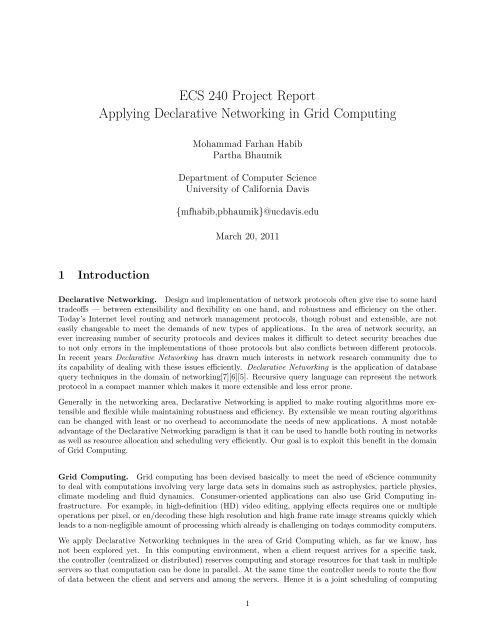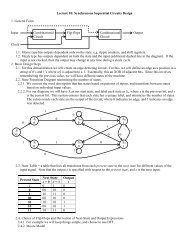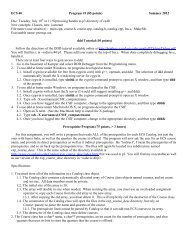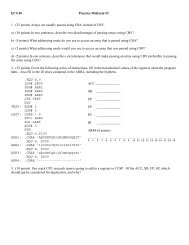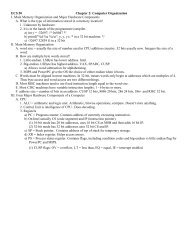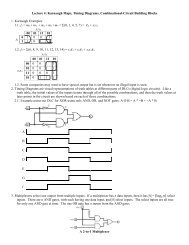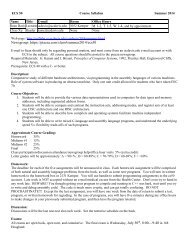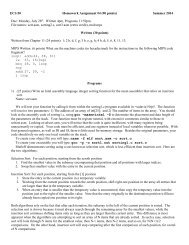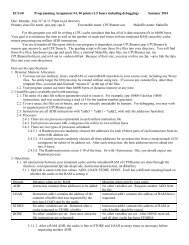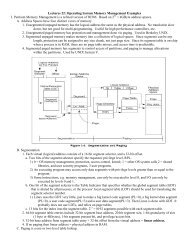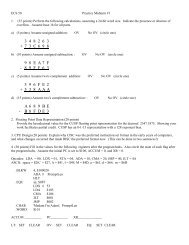link to the project report - CS-CSIF
link to the project report - CS-CSIF
link to the project report - CS-CSIF
You also want an ePaper? Increase the reach of your titles
YUMPU automatically turns print PDFs into web optimized ePapers that Google loves.
E<strong>CS</strong> 240 Project ReportApplying Declarative Networking in Grid ComputingMohammad Farhan HabibPartha BhaumikDepartment of Computer ScienceUniversity of California Davis{mfhabib,pbhaumik}@ucdavis.eduMarch 20, 20111 IntroductionDeclarative Networking. Design and implementation of network pro<strong>to</strong>cols often give rise <strong>to</strong> some hardtradeoffs — between extensibility and flexibility on one hand, and robustness and efficiency on <strong>the</strong> o<strong>the</strong>r.Today’s Internet level routing and network management pro<strong>to</strong>cols, though robust and extensible, are noteasily changeable <strong>to</strong> meet <strong>the</strong> demands of new types of applications. In <strong>the</strong> area of network security, anever increasing number of security pro<strong>to</strong>cols and devices makes it difficult <strong>to</strong> detect security breaches due<strong>to</strong> not only errors in <strong>the</strong> implementations of those pro<strong>to</strong>cols but also conflicts between different pro<strong>to</strong>cols.In recent years Declarative Networking has drawn much interests in network research community due <strong>to</strong>its capability of dealing with <strong>the</strong>se issues efficiently. Declarative Networking is <strong>the</strong> application of databasequery techniques in <strong>the</strong> domain of networking[7][6][5]. Recursive query language can represent <strong>the</strong> networkpro<strong>to</strong>col in a compact manner which makes it more extensible and less error prone.Generally in <strong>the</strong> networking area, Declarative Networking is applied <strong>to</strong> make routing algorithms more extensibleand flexible while maintaining robustness and efficiency. By extensible we mean routing algorithmscan be changed with least or no overhead <strong>to</strong> accommodate <strong>the</strong> needs of new applications. A most notableadvantage of <strong>the</strong> Declarative Networking paradigm is that it can be used <strong>to</strong> handle both routing in networksas well as resource allocation and scheduling very efficiently. Our goal is <strong>to</strong> exploit this benefit in <strong>the</strong> domainof Grid Computing.Grid Computing. Grid computing has been devised basically <strong>to</strong> meet <strong>the</strong> need of eScience community<strong>to</strong> deal with computations involving very large data sets in domains such as astrophysics, particle physics,climate modeling and fluid dynamics. Consumer-oriented applications can also use Grid Computing infrastructure.For example, in high-definition (HD) video editing, applying effects requires one or multipleoperations per pixel, or en/decoding <strong>the</strong>se high resolution and high frame rate image streams quickly whichleads <strong>to</strong> a non-negligible amount of processing which already is challenging on <strong>to</strong>days commodity computers.We apply Declarative Networking techniques in <strong>the</strong> area of Grid Computing which, as far we know, hasnot been explored yet. In this computing environment, when a client request arrives for a specific task,<strong>the</strong> controller (centralized or distributed) reserves computing and s<strong>to</strong>rage resources for that task in multipleservers so that computation can be done in parallel. At <strong>the</strong> same time <strong>the</strong> controller needs <strong>to</strong> route <strong>the</strong> flowof data between <strong>the</strong> client and servers and among <strong>the</strong> servers. Hence it is a joint scheduling of computing1
and communication resources. So far Declarative Networking has only been applied for routing, but jointrouting and resources scheduling is one area that has potential <strong>to</strong> be benefitted from Declarative Networking.Outline. The remainder of this <strong>report</strong> is organized as follows. Section 2 gives an account of <strong>the</strong> relatedwork in this area. An introduction <strong>to</strong> <strong>the</strong> declarative languages Datalog and NDlog is given in Sectionn 3.Our approach of application of Declarative Networking <strong>to</strong> Grid Computing is detailed in Section 4. FinallySection 5 concludes <strong>the</strong> <strong>report</strong>.2 Related workDeclarative Routing. Some of <strong>the</strong> early works in this area focus on <strong>the</strong> intuition behind declarativeprogramming of networks, and its root in Datalog[7][5]. NDlog, an extension <strong>to</strong> traditional Datalog hasbeen presented in <strong>the</strong> literature as a Network Pro<strong>to</strong>col Language. NDlog extends datalog <strong>to</strong> include <strong>the</strong>semantics of long-running queries over network state. In addition, several ramifications of <strong>the</strong> applicationof <strong>the</strong> Declarative Networking paradigm have been discussed like au<strong>to</strong>matic pro<strong>to</strong>col optimization and hybridization,program checking and debugging[6].Declarative Network Operation and Management. The declarative networking paradigm has alsobeen applied in <strong>the</strong> field of network management <strong>to</strong> ease complicated and error-prone operations. Thelack of au<strong>to</strong>mation in network management is mainly due <strong>to</strong> a lack of programmability at <strong>the</strong> right levelof abstraction. To address this issue, DECOR —a database-oriented declarative framework—has beenpresented [3]. Using DECOR, network management operations can be represented as a series of transactionaldatabase queries.Secure Distributed Systems. Much work has been done in <strong>the</strong> field of network security using DeclarativeNetworking. SeNDlog, a logic-based language, has been proposed for managing access control in distributedsystems [1]. There has also been efforts <strong>to</strong> investigate security challenges in cloud data management using<strong>the</strong> Declarative Secure Distributed Systems platform [9]. Some of <strong>the</strong> interesting challenges in this areainclude secure distributed data processing, end-<strong>to</strong>-end query result verification, and cross-user trust policymanagement.The SeNDlog language extends NDlog with basic security constructs for <strong>the</strong> implementation of secure distributedsystems. These are fur<strong>the</strong>r enhanced with type checking and meta-programmability in LBTrustsystem [8] for supporting different forms of encryption, delegation, for distributed trust management.Datacenter Programming. In <strong>the</strong> setting of cloud computing, <strong>the</strong> BOOM <strong>project</strong> is exploring <strong>the</strong> use ofdeclarative languages. The sequential programming models that are provided by current cloud platforms arenot suitable for inherently distributed resources. Overlog has been used <strong>to</strong> illustrate <strong>the</strong> benefits pf declarativeprogramming in a cloud; it acts as <strong>the</strong> basis for a simplified and enhanced reimplementation of a cloud-basedanalytics stack: <strong>the</strong> Hadoop File System (HDFS) and MapReduce infrastructure[2]. High level Overlogspecifications easily enable developers <strong>to</strong> quickly add sophisticated distributed features <strong>to</strong> networked systemsvia data partitioning, and implementations of new scheduling pro<strong>to</strong>cols and query processing strategies.O<strong>the</strong>r Miscellaneous Applications. Declarative Networking has also been successfully adopted in <strong>the</strong>areas of mobility-based overlays, adaptively hybridized mobile ad-hoc networks, overlay network composition,sensor networking, fault-<strong>to</strong>lerant pro<strong>to</strong>cols, network configuration, replicated filesystems, distributed machinelearning algorithms, and robotics.2
3 Languages: Datalog and NDlogLoo et al. [7] have formally defined <strong>the</strong> Network Datalog (NDlog) language for declarative networking.The NDlog language is based on extensions <strong>to</strong> traditional Datalog, a well-known recursive query languagetraditionally designed for querying graph-structured data in a centralized database.Datalog. A Datalog rule has <strong>the</strong> form p : −q 1 , q 2 , ..., q n , which can be read informally as q 1 and q 2 and ...and q n implies p. p is <strong>the</strong> head of <strong>the</strong> rule, and q 1 , q 2 , ..., q n is a list of literals that constitutes <strong>the</strong> bodyof <strong>the</strong> rule. Literals are ei<strong>the</strong>r predicates over fields (variables and constants), or function symbols applied<strong>to</strong> fields. The rules can refer <strong>to</strong> each o<strong>the</strong>r in a cyclic fashion <strong>to</strong> express recursion. The order in which <strong>the</strong>rules are presented in a program is semantically immaterial. The commas separating <strong>the</strong> predicates in arule are logical conjuncts (AND); <strong>the</strong> order in which predicates appear in a rule body also has no semanticsignificance, though most implementations employ a left-<strong>to</strong>-right execution strategy. The query specifies <strong>the</strong>output of interest.Most implementations of Datalog enhance it with a limited set of function calls (which start with “f” instandard syntax), including boolean predicates and arithmetic computations. Aggregate constructs arerepresented as functions with field variables within angle brackets ().Towards Network Dalalog. NDlog tries <strong>to</strong> integrate networking and logic, which is unique from <strong>the</strong> perspectiveof both domains. As a network pro<strong>to</strong>col language, it is notable for <strong>the</strong> absence of any communicationprimitives like “send” of “receive”; instead, communication is implicit in a simple high-level specification ofdata partitioning. In comparison <strong>to</strong> traditional logic languages, it is enhanced <strong>to</strong> capture typical networkrealities including distribution, <strong>link</strong>-layer constraints on communication and soft state semantics.The properties of NDlog are as follows.ˆˆˆˆDistributed Computations: Since network pro<strong>to</strong>cols are typically computations over distributednetwork state, one of <strong>the</strong> important requirements of NDlog is <strong>the</strong> ability <strong>to</strong> support rules that expressdistributed computations. NDlog builds upon traditional Datalog by providing control over <strong>the</strong> s<strong>to</strong>ragelocation of tuples explicitly in <strong>the</strong> syntax via location specifiers. Each location specifier is a field withina predicate that dictates <strong>the</strong> partitioning of <strong>the</strong> table. In standard implementation, a “@” symbol isprepended <strong>to</strong> a single field denoting <strong>the</strong> location specifier. Each tuple generated is s<strong>to</strong>red at <strong>the</strong> addressdetermined by its location specifier. [6]Link-restricted communications: In order <strong>to</strong> send a message in a low-level network, <strong>the</strong>re needs<strong>to</strong> be a <strong>link</strong> between <strong>the</strong> sender and receiver. This is not a natural construct in Datalog. Hence, <strong>to</strong>model physical networking components where full connectivity is not always available, NDlog providessyntactic restrictions that can be used <strong>to</strong> ensure that rule execution results in communication onlyamong nodes that are physically connected. This is syntactically achieved with <strong>the</strong> use of <strong>the</strong> special#<strong>link</strong> predicate in all NDlog programs. [4]Soft-state data and rules: In typical network pro<strong>to</strong>cols, <strong>the</strong> generated network state is maintained assoft-state data. In <strong>the</strong> soft state s<strong>to</strong>rage model, s<strong>to</strong>red data have a lifetime or time-<strong>to</strong>-live (TTL), andare deleted when <strong>the</strong> lifetime has expired. The soft state s<strong>to</strong>rage model requires periodic communication<strong>to</strong> refresh network state. Soft state is often favored in networking implementations because in a verysimple manner it provides well-defined eventual consistency semantics. Intuitively, periodic refreshes<strong>to</strong> network state ensure that <strong>the</strong> eventual values are obtained even if <strong>the</strong>re are transient errors suchas reordered messages, node disconnection or <strong>link</strong> failures. While soft state is useful for maintainingdistributed state, we also make extensive use of traditional “hard-state” data with infinite lifetimes fors<strong>to</strong>ring persistent counters, local machine state and archival logs. [4]Incremental maintenance of network state: In practice, most network pro<strong>to</strong>cols are executedover a long period of time, and <strong>the</strong> pro<strong>to</strong>col incrementally updates and repairs routing tables as3
nication can be described in synchronized iterations, where at each iteration, each network node generatesreachable tuples where <strong>the</strong> distance between S and D is increasing by 1. The tuples are <strong>the</strong>n propagated <strong>to</strong>neighbor nodes along bi-directional network <strong>link</strong>s (shown in bi-directional dashed arrows in <strong>the</strong> figure).Initially all <strong>the</strong> nodes have <strong>the</strong> <strong>link</strong> tuples only, which s<strong>to</strong>re information about <strong>the</strong> <strong>link</strong>s (edges) in <strong>the</strong> graph.In <strong>the</strong> first iteration, all nodes initialize <strong>the</strong>ir local reachable tuples using <strong>the</strong> rule R1. In <strong>the</strong> second iteration,using rule R2, each node takes <strong>the</strong> input reachable tuples generated in <strong>the</strong> previous iteration and computesnew reachable tuples, which are <strong>the</strong>n propagated <strong>to</strong> <strong>the</strong> neighbours. For example reachable(@a,c) isgenerated at node b using reachable(@b,c) from <strong>the</strong> first iteration, and propagated <strong>to</strong> node a. In this wayafter sufficient number of iterations all <strong>the</strong> reachable tuples are populated.Execution of NDlog queries. In <strong>the</strong>ir implementation [6], Loo et al. explain that <strong>the</strong> runtime executionof NDlog programs differs from <strong>the</strong> traditional implementation patterns for both network pro<strong>to</strong>cols anddatabase queries. Network pro<strong>to</strong>col implementations often center around local state machines that emitmessages, triggering state transitions at o<strong>the</strong>r state machines. In contrast, <strong>the</strong> runtime system for NDlog isa distributed dataflow execution engine, similar in spirit <strong>to</strong> those developed for parallel database systems,and also in recent parallel map-reduce implementations.The authors describe <strong>the</strong> four main phases of <strong>the</strong> query execution system Centralized Plan Generation,Distributed Plan Generation, Semi-naïve Evaluation and Incremental Maintenance. We skip <strong>the</strong> details here,but <strong>the</strong>y are interesting from a database research perspective.4 Our ApproachDeclarative Networking has been applied in many areas such as intra and inter domain routing pro<strong>to</strong>cols (e.g.,Distant Vec<strong>to</strong>r Routing, BGP), Overlay pro<strong>to</strong>cols (e.g., Chord DHT), Distributed systems (e.g., Gnutella),Network management configuration and security verification and so on. How this technique can be used <strong>to</strong>express Grid computing pro<strong>to</strong>cols is an interesting problem. The ultimate goal of declarative networkingresearch is <strong>to</strong> represent each and every pro<strong>to</strong>cols used in <strong>to</strong>day’s network using declarative language <strong>to</strong>make it more flexible and extensible so that <strong>the</strong> network can easily be changed <strong>to</strong> meet <strong>the</strong> demands of newtypes of applications in <strong>the</strong> coming days. We want <strong>to</strong> contribute by exploring <strong>the</strong> possibilities of applyingthis technique in <strong>the</strong> design of Grid Computing. Grid computing has been devised basically <strong>to</strong> meet <strong>the</strong>need of eScience community <strong>to</strong> deal with computations involving very large data sets in domains such asastrophysics, climate modeling and fluid dynamics. In a grid, a set of clusters are interconnected with highbandwidth transmission lines. This set of clusters forms a common pool of computing and s<strong>to</strong>rage resourcesfor end users. We will look at <strong>the</strong> grid dimensioning problem which means figuring out how <strong>to</strong> schedulecomputing and s<strong>to</strong>rage resources for an incoming request and routing <strong>the</strong> request efficiently through <strong>the</strong> gridso that it optimizes resource usage. Declarative programming can be used <strong>to</strong> describe all <strong>the</strong>se resourcesand usage constraints in a unified manner.5 Conclusions5
References[1] Martín Abadi and Boon Thau Loo. Towards a declarative language and system for secure networking.In Proceedings of <strong>the</strong> 3rd USENIX international workshop on Networking meets databases, pages 2:1–2:6,Berkeley, CA, USA, 2007. USENIX Association.[2] Peter Alvaro, Tyson Condie, Neil Conway, Khaled Elmeleegy, Joseph M. Hellerstein, and Russell <strong>CS</strong>ears. Boom: Data-centric programming in <strong>the</strong> datacenter. Technical Report UCB/EE<strong>CS</strong>-2009-98,EE<strong>CS</strong> Department, University of California, Berkeley, Jul 2009.[3] Xu Chen, Yun Mao, Z. Morley Mao, and Jacobus Van der Merwe. Decor: Declarative network managementand operation. SIGCOMM Comput. Commun. Rev., 40:61–66, January 2010.[4] Boon Thau Loo. The Design and Implementation of Declarative Networks. PhD <strong>the</strong>sis, EE<strong>CS</strong> Department,University of California, Berkeley, Dec 2006.[5] Boon Thau Loo, Tyson Condie, Minos Garofalakis, David E. Gay, Joseph M. Hellerstein, Petros Maniatis,Raghu Ramakrishnan, Timothy Roscoe, and Ion S<strong>to</strong>ica. Declarative networking: language, executionand optimization. In Proceedings of <strong>the</strong> 2006 ACM SIGMOD international conference on Managemen<strong>to</strong>f data, SIGMOD ’06, pages 97–108, New York, NY, USA, 2006. ACM.[6] Boon Thau Loo, Tyson Condie, Minos Garofalakis, David E. Gay, Joseph M. Hellerstein, Petros Maniatis,Raghu Ramakrishnan, Timothy Roscoe, and Ion S<strong>to</strong>ica. Declarative networking. Commun. ACM, 52:87–95, November 2009.[7] Boon Thau Loo, Joseph M. Hellerstein, Ion S<strong>to</strong>ica, and Raghu Ramakrishnan. Declarative routing:extensible routing with declarative queries. In Proceedings of <strong>the</strong> 2005 conference on Applications, technologies,architectures, and pro<strong>to</strong>cols for computer communications, SIGCOMM ’05, pages 289–300, NewYork, NY, USA, 2005. ACM.[8] William R. Marczak, David Zook, Wenchao Zhou, Molham Aref, and Boon Thau Loo. Declarativereconfigurable trust management. In Proceedings of Conference on Innovative Data Systems Research(CIDR), 2009.[9] Wenchao Zhou, Micah Sherr, William R. Marczak, Zhuoyao Zhang, Tao Tao, Boon Thau Loo, and InsupLee. Towards a data-centric view of cloud security. In Proceedings of <strong>the</strong> second international workshopon Cloud data management, CloudDB ’10, pages 25–32, New York, NY, USA, 2010. ACM.6


